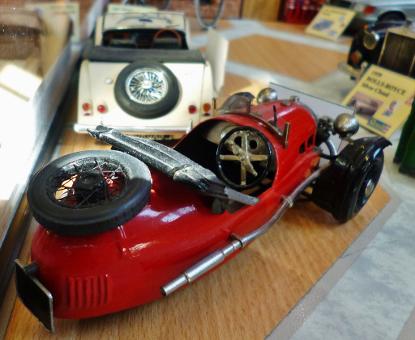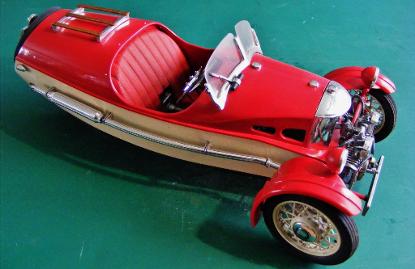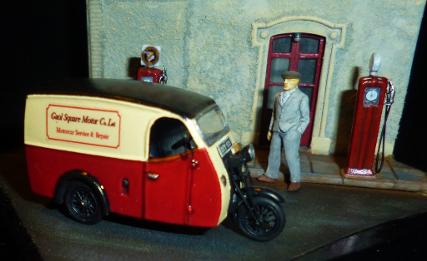The Cyclecar and three wheeler collection.
From the earliest days of the automobile the balance between weight and power has been a vital component of the design process. For some the simplest way to reduce weight was to leave out one of the wheels.
If this design was a bit weird for some the sporty nature of light cars and powerful engines appealed to many others. When governments got involved three wheelers could be a neat tax dodge and a whole new group of people wanted an affordable mode of transport.
1885 Benz Prototype.
1/24th scale scratch built model
Obviously a three wheeler Benz' car was purely and engineering exercise, could he make a cart that propelled itself along the road? Having achieved his goal Benz was quite happy to set the car aside and move onto his next query.
It was his wife Bertha that really got the motor car into the public psyche and we owe a great deal of our modern travel convenience to that great lady.
A quick glance at the vehicle reveals all the points that would later be the hall marks of cyclecars. Lightweight, bicycle style wire wheels and chain drive.
1886 de Dion, Bouton & Trepardoux steam Quadricycle
1/24th scale scratchbuilt model.
In 1882 a small Parisian engineering workshop run by Georges Bouton and Charles Trépardoux was visited by the young Count de Dion. He had seen their models and scientific toys, including a beautifully made small steam engine and he was anxious to meet the makers.
Count de Dion himself had an engineering interest and he was looking for someone to work with him in building a steam vehicle to vie with the new spirit driven automobiles. The design is four wheeled but with the two driven rear wheels so close together it has the appearance of a tricycle. The vehicle also has pneumatic tyres which is one of the earliest uses of them on a motor car.
A similar vehicle took part in the very first organised automobile competition in 1887, the 2km course ran from Neuilly Bridge to the Bois de Boulogne. Georges Bouton won the event on the de Dion, Bouton & Trépardoux machine.
1888 NSU-Daimler stahlradwagon
1/24th scale scratch built model
The Steel (or wire) wheel car was commissioned by Daimler to be built by NSU at Neckarsulm and was in effect their first production car. Clearly aimed at reducing weight, and relying heavily on NSU's expertise in making bicycles, this car can easily be recognised as the first of what would latter be called cyclecars.
The vehicle had a tubular steel chassis that carried the engine beneath the seat and drove a Zahnrad four speed gearbox. The surface carburetor also supplied fuel to the hot-rod ignition burners. Braking was by external contracting system operating on the right rear wheel only. The car was first shown to the public at the Paris World Fair in 1889. Just 10 were made.
1934 Morgan Supersport "Beetleback"
1/24th scale SouthEastern Finecast kit.
When in 1909, at the age of 28, Henry Frederick Stanley Morgan (HFS as he came to be known in the motoring world) designed and built his first single-seat three-wheeled experimental car.
HFS worked as a draughtsman for the Great Western Railway until 1906, when he left and went into partnership with a close friend. His father put up £3,000 and they opened a garage in Malvern and a few months later another in Fore Street, Worcester. Production of the Morgan Motor Company commenced in 1910. Even then he could never have dreamed that he would become one of the world’s major manufacturers of three wheel cars.
The 1934 model has the spare wheel placed on the rear deck for ease of access. It certainly worked but it took away the one place luggage might have been stored. If the spare isn't sitting on the deck you can see the reason why these models became known as the "beetlebacks".
1935 Morgan Supersport "Barrelback"
1/16th scale Academy kit.
The problem of where to put the spare wheel was finally solved in 1935 with the modification to the rear bodywork to create the ‘barrelback’.
The Aero Sport was among the last of the three wheel models to be built before production went over to 4-wheel cars.
1936 Reliant 8cwt light delivery van
1/72nd scale Autocraft kit.
Although often laughed at the Reliant firm was once known for much better feats than comedy turns.
Born out of the Raleigh cycle company's abortive attempts to break into the small car market Tom Lawrence Williams and E.S. 'Tommo' Thompson combined to set up Reliant. They built upon the promising start Raleigh had made before the firm decided to drop out of car and light van production and refined the "Karryall" style designs to product a range of vans that filled a special niche in the light delivery market.
1955 Daihatsu CM10T
1/32nd scale Arii kit.
Although often dwarfed by the better known Japanese auto manufacturers Daihatsu is actually the oldest car manufacturer in Japan. Daihatsu Motor Co., Ltd. is known mainly for it's small cars and off-road vehicles. Originally the Osaka company was founded in 1907 and called Hatsudoki Seizo Co. Ltd and built engines for power plants. In 1951 it was re-branded as Daihatsu and started exports to Europe in the 1960s but sales didn't really take off until the 1980s.
Like Mazda Daihatsu made three wheeled trucks for the versatility they offered in the tight crowded cities of Japan.
1958 Messerschmitt KR200 cabriolet
1/43rd scale Tober Models kit
When Messerschmitt were prohibited from making aircraft after WWII the company began diversifying. One of their investment projects was a development of an invalid carriage designed by Fritz Fend.
Fend convinced Messerschmitt to take on his latest design and in 1952 they set up an entirely new company and production base for the project. By 1956 Messerschmitt were back in the aircraft industry and the Company and production line were sold to Fend and his partner in the project Valentin Knott.
In 1957 the KR200 Kabrio model were built. These models had a cloth convertible top and fixed side window frames. This was followed by 300 limited edition KR201 Roadsters which had a folding cloth top, a windscreen, and removable side curtains. Another new model was the Sport Roadster which had only a windscreen and a tonneau cover with wood side trim were the side window frames used to be.
1958 Mazda K360 trike
1/32nd scale Arii kit
Mazda began as the Toyo Cork Kogyo Co., Ltd, founded in Hiroshima, Japan in 1920. Toyo Cork Kogyo was renamed to Toyo Kogyo Co., Ltd. in 1927. In the late 1920s the company had to be saved from bankruptcy by Hiroshima Saving Bank and other business leaders in Hiroshima. In 1931 Toyo Kogyo moved from manufacturing machine tools to vehicles with the introduction of the Mazda-Go auto-rickshaw, the first ‘vehicle’ manufactured by Mazda.
1962 Messerschmitt KR200
1/24th scale gunze Sangyo kit.
When Messerschmitt were prohibited from making aircraft after WWII the company began diversifying. One of their investment projects was a development of an invalid carriage designed by Fritz Fend.
Fend convinced Messerschmitt to take on his latest design and in 1952 they set up an entirely new company and production base for the project. By 1956 Messerschmitt were back in the aircraft industry and the Company and production line were sold to Fend and his partner in the project Valentin Knott.
Production continued until 1965 when Germany's booming economy, and the ever increasing popularity of the British Mini saw demand for these novel little cars fall away.
1954 BMW Isetta 300
1/24th scale Gunze Sangyo kit.
First introduced at the 1953 Turin motor show the Isetta, or "little Iso" was intended to fill the affordable economical car market. It was soon being built all over Europe under licence and is often credited as being the "little car that saved BMW".
Through the 1950s and '60s micro cars were all the rage and the shape of the Isetta led to them being generally called "Bubblecars".
Popularity of the Isetta waned through the 1960's with the introduction of the more spacious and practical VW Beetle, Fiat 500 and Austin/Morris Mini eating into sales, by the end of the decade it was all but obsolete.
1962-72 Mazda T2000
1/32nd scale Arii kit.
The tadpole shaped T2000 was in production from 1962 to 1972 and was basically unchanged throughout its production. With just 80 hp it’s hardly a powerhouse but it was enough to do the job. By the 1970s Mazda was selling to the rest of the world and the demand for stronger, more powerful four wheeled trucks saw Mazda move away from this typically far Eastern style of vehicle.
Built and donated by John Jenkins










